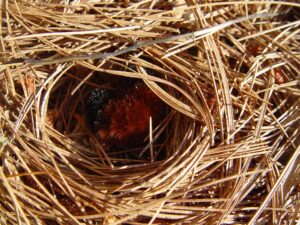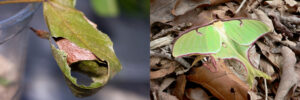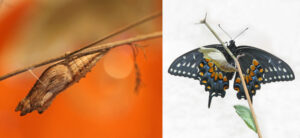
Woolly bear caterpillars construct shelters like this one made from pine needles to protect themselves from the winter elements. They also commonly use leaf litter and other yard debris. Image by batwrangler on flickr.
Wandering fall caterpillars promise the presence of pollinators, bird food, and flashes of fluttering color in your yard next spring, but overly enthusiastic yard cleanup can make you lose out on these benefits. These insects can provide your spring plants with pollination and migratory birds with a snack. You can help them by changing the timing of your yard clean up.
Fall: Caterpillar Watching Season
Caterpillars are encountered more frequently in the fall for two reasons: their size and their hunt for a home. Many large caterpillars require a full growing season to reach their final stage. Come fall, caterpillars that might have easily blended in with a twig or leaf, are more likely to stand out to the human eye because of their sheer size. In addition, many of these caterpillars spend the winter in cocoons or chrysalises (pupae) or as caterpillars. They have adaptations to help resist the cold, but most still need a shelter to tuck themselves away in to stay safe. Caterpillars often cross paths with people when they go looking for these shelters. The most famous of these wandering fall caterpillars is the woolly bear caterpillar (aka the Isabella tiger moth), but many others like tussock moths, silk moths (e.g. Luna, Io, and polyphemus moths), and sphinx moths are also commonly encountered.

Luna moth cocoons are often difficult to see because they are generally wrapped in dead leaves. If the cocoon survives the winter, it will emerge in the spring as a soft green, 3 to 4.5 inch moth. Images by Greg Gilbert and wanderingnome on flickr.
Caterpillars and Your Yard
In addition to turning into some of the most charismatic insects (Luna moths, monarchs, swallowtails, etc.), caterpillars play a complex and pivotal role in the ecosystem. Many bird species rely on caterpillars during their nesting period. These insects are tiny packets of protein and other nutrients that growing birds need to survive. Encouraging a healthy crop of caterpillars can be just as effective at drawing birds to your yard as a birdfeeder. Once caterpillars turn into moths or butterflies, they play another key role in the garden. Many butterflies and moths are important pollinators. Keeping them alive over the winter helps ensure they’ll fill these roles in the spring.
“Hibernating” Caterpillars

Swallowtail caterpillars often attach their chrysalises to dead plant material in the fall. The chrysalises are brown and resemble dead leaves. In the spring, the swallowtail butterflies emerge and look for flowers to drink from. They are just one of many butterfly and moth pollinators. Images by Vicki DeLoach.
Caterpillars and other insects (e.g. solitary bees) often tuck themselves away in places that would be perfectly safe in an unmanaged field or forest but are dangerous for them in a yard or landscaped area. Many insects use dead plant matter like dead leaves, fallen tree trunks, or standing dead vegetation for insolation and camouflage during the winter. Luna moths, for example, bind together leaves to make themselves a crunchy sleeping bag to spend the winter. The dead leaves can help hide the moth’s cocoon from hungry animals and insolate them from the winter weather. They are so well camouflaged that they can be raked into a leaf pile without being noticed. As long as they are not diseased, putting fallen leaves in mulch piles or in the woods rather than burning or throwing them away can help ensure Luna moths and other beneficial insects survive into the next year.
Caterpillars and solitary bees both use dead plant stocks to overwinter. Many hide inside the stems, but other attach themselves to the outside. Some species of swallowtail butterflies spend the winter as a chrysalis that looks like a dead leaf. They attach themselves to twigs, dead plants, and tree trunks. Removing dead stems in gardens in the fall runs the risk of killing these butterflies and other pollinators. With some careful planning, you can keep your yard butterfly, moth, and bee friendly while also making it tidy and disease free (Learn more here: https://www.purduelandscapereport.org/article/protect-pollinators-and-plants-with-a-balanced-fall-garden-cleanup-plan/ ).
Cover photo by Sue Thompson